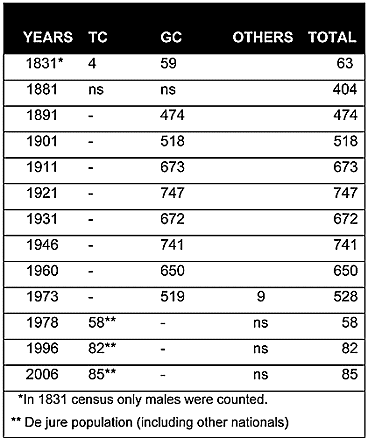

As can be seen from the chart above, the village was almost always inhabited exclusively by Greek Cypriots. During the first half of the 20th century its population steadily increased from 518 in 1901 to 747 in 1921. However, for reasons that are not clear, its population declined to 672 persons in 1931. There was a temporary recovery after the Second World War, with the numbers increasing to 741 in 1946, but after Cyprus’s independence in 1960 it again dropped to 650. Its population continued to decrease in the 1960s. The 1973 census put Karmi’s population at 528.
Displacement:
All of the village’s Greek Cypriot inhabitants fled after July 20th 1974. Currently, like the rest of the displaced Greek Cypriots, the Greek Cypriots of Karmi are scattered throughout the island’s south. The displaced Greek Cypriot population of Karmi can be estimated to be around 520, since its Greek Cypriot population was 519 in 1973.
Current Inhabitants:
Following the displacement of the Greek Cypriot inhabitants of the village in 1974, the village was repopulated in 1975 by some persons who were mostly employed in the tourism sector in Kyrenia. However, the village’s relative distance from the town of Kyrenia, and the ensuing transportation difficulties created discontent amongst the new inhabitants. It is reported that this discontent took the form of protest, and that some even burned furniture and houses. They were removed from the village immediately. The village was never considered a desirable place of relocation by Turkish Cypriots, who refused to be resettled there. As a result, the village remained almost entirely empty for many years, apart from some European inhabitants who had resided in the village before 1974. By the 1980s the disrepair of the village convinced Turkish Cypriot authorities to allow foreigners to take the village’s houses on long-term leases on the condition that they restore them. Currently almost all of Karmi’s inhabitants are Europeans who took up the authorities’ offer of long-term leases and restored the village’s houses. Although the 2006 census shows only 85 people living permanently in Karmi, during certain vacation periods the number of inhabitants can go up to 300. Because new housing was developed in the lower part of Karmi (Aşağı Karaman), this area is more populated than the actual village. The 2006 census put Lower Karmi/Aşağı Karaman’s population at 565.
Websites: